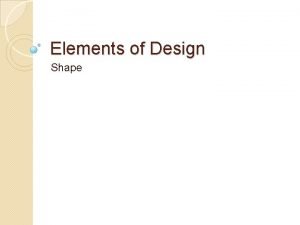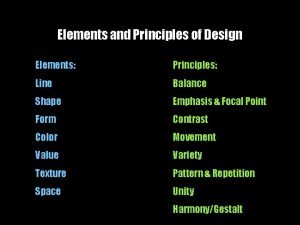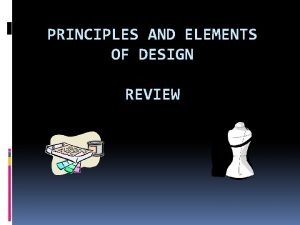Chapter 3 Design Principles and Elements The Principles






- Slides: 6

Chapter 3 Design Principles and Elements The Principles of Design • Scale • Proportion • Balance • Rhythm • Emphasis • Harmony

Chapter 3 Design Principles and Elements The Principles of Design: Scale and Proportion Scale. Overall size, such as the largeness or smallness of a room, object, or pattern. Proportion. Size relationship or ratio of parts to whole, such as the size of a chair in relation to the size of its arms. Golden Mean- A line that visually divides an object Pleasing proportions were termed “golden” by the Ancient Egyptians and later the classical Greeks A line that falls visually between 1/2 and 1/3 vertically or horizontally Golden Section- A theory of pleasing proportions based in the sequence 2: 3: 5: 8: 13: 21, ad inf. , where a portion or section of a line relates best to its neighbors in measurements of these of equivalent increments.

Chapter 3 Design Principles and Elements The Principles of Design: Balance- Equilibrium achieved by arranging components symmetrically, asymmetrically, or radially. Equilibrium is the arrangement of objects physically or visually to reach a state of stability and poise. The state of equilibrium is achieved one of three ways: Symmetrical or formal balance Symmetrical balance=mirror image Symmetrical balance suggests restraint, refinement, orderliness and formality. It is passive because we know exactly what to expect. Classical design-symmetry created a sense of power and grandeur. Asymmetrical or informal balance Can be accomplished in two ways: 1. Dissimilar Objects can be placed at varying distances from the center point 2. Objects of similar visual weight or form may be balances at equal distance from an imaginary dividing line. Radial balance-based on the circle

Chapter 3 Design Principles and Elements The Principles of Design- Rhythm- Flow of elements, usually organized according to a scheme such as repetition or alternation, progression or gradation, transition, opposition or contrast, or radiation. Repetition- establishes rhythm through the repetitive use of a design element. Ex. Using the same windows throughout the home Alternation- sequence of two or more components by which the eye can follow a rhythmic pattern. Ex. egg and dart motif Progression or gradation- shapes progressing from small to large Ex. nesting tables also relative to progression in color value

Chapter 3 Design Principles and Elements The Principles of Design-Rhythm Continued Transition- rhythm that leads the eye without interruption from one point to another. Ex. crown molding Opposition or contrast- an abrupt change that forms an interesting, repetitive rhythm and is seen in three ways: • Repetitive 90 degree angles • Patterns, ex. open and closed, busy and plain, light and dark combinations of fabric etc. • Pleasing rhythm, ex. angular shapes placed next to rounded shapes Radiation-closely related to radial balance, ex. large scale ballroom: small scale, round table with place settings. EX. FIGURE 3. 10

Chapter 3 Design Principles and Elements The Principles of Design-Emphasis and Harmony Emphasis. Enhancement that produces a point of interest or focal point in a design. Focal Point- an area visually important enough to draw and hold attention. EX. FIGURE 3. 11 Harmony. Compatibility of elements to create a pleasing whole, achieved through unity and variety. Unity-suggests a oneness and uniformity and identity that establishes a master plan. Variety- The absence of monotony or sameness. Brings about vitality, interest and diversity










